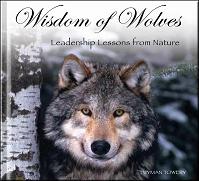 An excerpt from Wisdom of Wolves: Leadership Lessons from Nature by Twyman Towery
An excerpt from Wisdom of Wolves: Leadership Lessons from Nature by Twyman Towery
What a gorgeous sight! As wolves travel the vast horizons in search of their prey, they traverse the snow. One of their favorite methods of travel is single file, one directly behind the other. The lead wolf expends the most energy. He is the trailblazer, crashing through the soft snow, allowing each succeeding wolf to conserve energy. When the lead wolf tires, he may drop off to the side and allow the next wolf to assume the lead position. The former lead wolf can not trail the other pack members, laboring less and regaining his strength for the challenges yet to come.
While the wolf pack is lead by an Alpha male and Alpha female, each wolf assumes a share of responsibility for the welfare of the pack. For example, after a litter of pups is born, an uncle will often assume the job of “chief baby-sitter” so the Alpha female can join the Alpha male on a honeymoon hunt, allowing her some respite from her motherly duties. Every member of the pack does not aspire to be the boss – some prefer to be steady hunters, caretakers or scouts. But everyone has a crucial role to play.
From the early playful romping with elders, the wolf pup is carefully trained to assume his part of the leadership of the pack as if his life and that of the pack depend upon it. For they do. It is the same with successful organizations and families. Members must be prepared not only to carry their own load but also to assume greater leadership at any time. The viability of the organization may well depend upon it.
Wolves not only cooperate with each other but also may work in harmony with other species to reach mutually desirable goals, and sometimes just to have fun. The raven is a case in point. An expert, skilled observer from above, when the raven discovers wounded or dead prey, it often acts as a messenger, summoning the wolf and other ravens to the scene. The wolves can open the carcass, thus providing enough food for everybody for days to come.
While the wolf may make playful lunges at the wily bird, and the raven may peck the wolf’s rump while he’s feeding, the two not only coexist, but obviously enjoy an intricate partnership forged from nature’s law of efficiency and thousands of years of experience.
There is also a more intricate, less definable type of teamwork in which wolves are key participants. It is exemplified by their successful introduction into Yellowstone National Park after years of research, planning, political perseverance and masterful execution by literally thousands of people from all different strata of our society. Once released, the wolves have more than done their part – they have not only survived but have prospered and procreated beyond even the most optimistic projections. While there have been problems involved in this delicate operation, they have been much less significant than expected, and many formerly dubious ranchers have become staunch supporters of this reintroduction program.
Not only has the teamwork of the wolves among themselves been critical to their success, but the teamwork between humans and wolves has helped boost the life environment for both species.
The thrill felt by millions of people knowing that this great predator once again roams the vast expanse of Yellowstone is immeasurable. This great success story gives at least one positive sign for a future in which humans and wolves may coexist. Indeed, it is an apt metaphor for the kind of teamwork you and your company may need with your vendors, suppliers, distributors and even your competitors.
To learn more about Wisdom of Wolves: Leadership Lessons from Nature, please click here!
Reprinted by permission of Simple Truths (c) 2011. In order to protect the rights of the copyright holder, no portion of this publication may be reproduced without prior written consent. All rights reserved.

